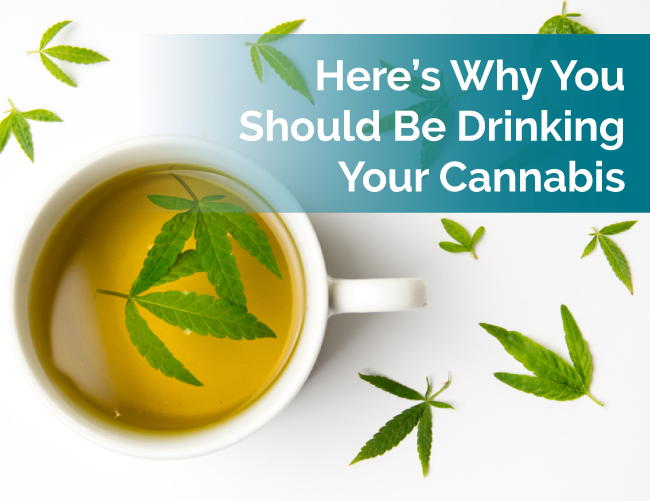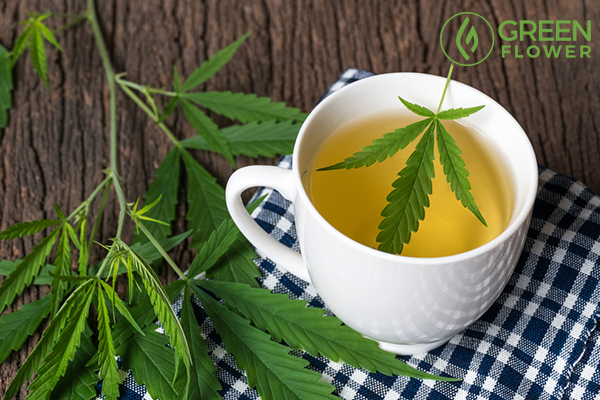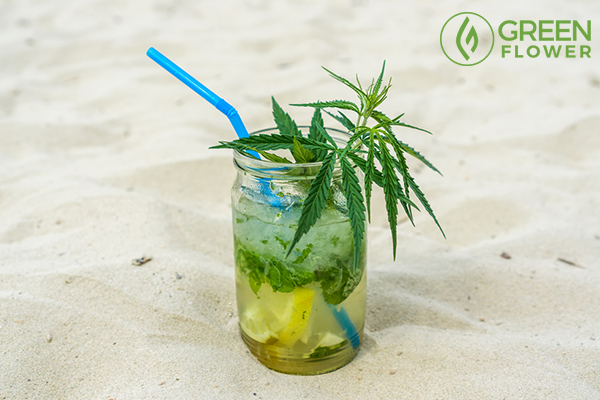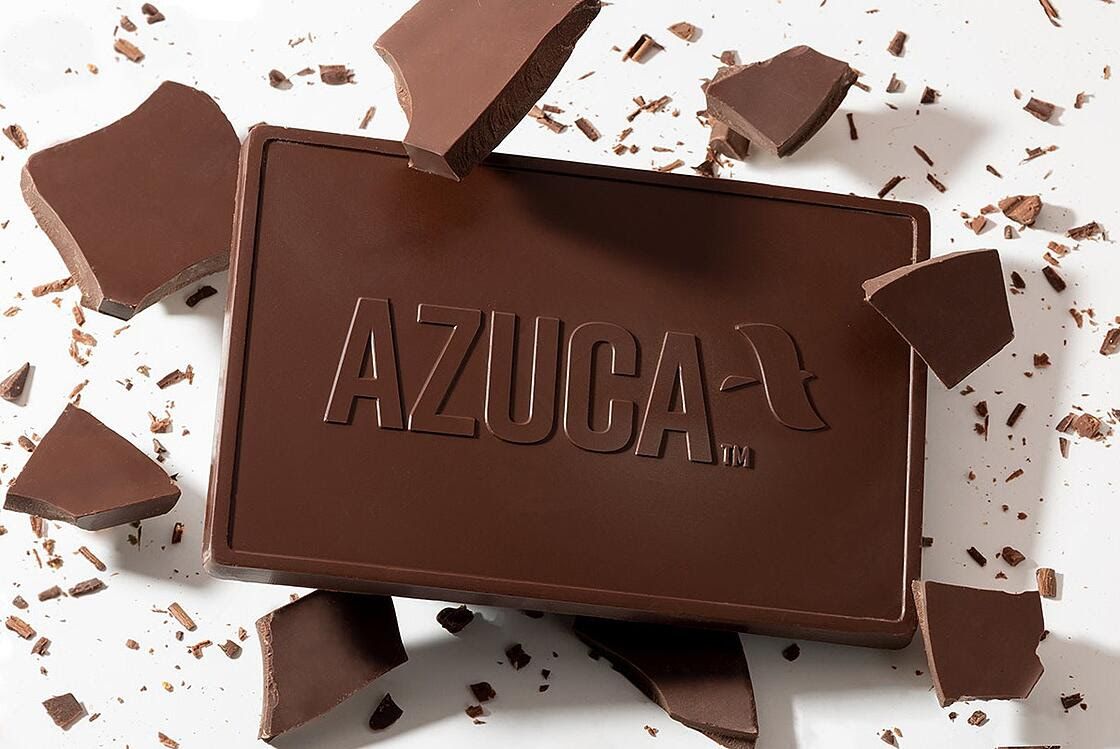Here’s Why You Should Be Drinking Your Cannabis

Many medical marijuana patients are familiar eating and smoking cannabis. But many may not realize that some consider drinking marijuana healthier than smoking it. Sure, smoking is the fastest way to deliver THC to your mind and body.
Why the Sudden Interest in Marijuana Drinkables?
Smoked cannabis kicks in within a few minutes. The noticeable high lasts for 1 to 3 hours. Then you become "sober." Drinkables, on the other hand, take 30 to 60 minutes to kick in, but the effects last for 4 to 8 hours and then slowly descend. It’s because of these long-lasting effects that people find drinkables particularly helpful in the treatment of conditions such as nausea and chronic pain.
Additionally, when you drink marijuana, the THC produces more body-centered effects compared to smoking, and the impact is more evenly distributed all over your body. For this reason, drinking marijuana is a more effective method for treating muscle spasms, epilepsy and other similar conditions. The best part is the burned-out effect you sometimes get after smoking marijuana is less noticeable when you drink marijuana.
Dosage for Drinkables
As with any other method of ingesting weed, finding the appropriate dose will take some experimentation. If you haven’t used marijuana before in any form, start out with a tiny bit. This will help you get accustomed to its associated effects and sensations.
For instance, you can begin with 1/2 cup per day. If you’re a regular user, go with 1 cup per day. If you find you need more for relief, you can bump up to 2 cups per day, taken at intervals of 12 hours.
4 Delicious Marijuana Beverages and Drinks With Recipes
Here are a few of the most popular types of weed-infused drinks.
1. Coffee and Tea
Marijuana coffee or tea is perfect for when you simply want to unwind, watch TV and relax without having to deal with the negative effects of smoke. There is a considerably higher solubility of THC in hot beverages than in cold ones.
You can either make tea, coffee, cappuccino or mocha for instant medicine. It’s the perfect way to jump-start the day, delivering an instant burst of energy and relief from your chronic disease symptoms, just the way nature intended it.
Marijuana Tea/Weed Tea Recipe
What You’ll Need: 1 tea cup, 1 tsp. cannabutter and a tea bag.
Directions
2. Soda and Lemonade
Thanks to new technology developing in the world of marijuana, we can now make sugary carbonated beverages with tinctures. If you’re looking for a quick hit that will perk you up, marijuana sodas and lemonades will leave you smiling. They’re super-refreshing and an easy way to get the benefits of your medicine.

Cannabis Lemonade Recipe
What You’ll Need: Blender, sieve, jug, water, sugar, 1 juiced lemon, 4 tablespoons weed tincture and 6 mint leaves.
Directions
Put sugar, water and lemon juice into a blender. Let it blend for 15 seconds or until everything is well blended.
Stir in the weed tincture and mint leaves. Run through the sieve into the jug.
Chill in the refrigerator or serve immediately over ice.
With a drink this refreshing and sweet, you can never go wrong with lemonade on a hot day.
3. Syrups
Cannabis-infused syrups are introducing young people to the goodness of concentrated liquid cannabinoids. Once you’ve made a bottle of cannabis simple syrup, you can use it to add a little dose of THC to your favorite drinks. You can always spike your tea or coffee, mix it into a smoothie, make a glass of lemonade or cool off with a canna-cocktail. Whatever you want to make, this recipe for cannabis syrup should be your starting place.
Cannabis Simple Syrup Recipe
What You’ll Need: 3 cups water, 3 cups fine sugar, 2 tablespoons vegetable glycerin, 2 grams finely ground cannabis, strainer or cheesecloth.
Directions
Put the sugar and water into a pot. Bring to a boil, then stir until all the sugar dissolves.
Once sugar is dissolved and the mixture is boiling, add cannabis. Cover and let it continue boiling for 20 minutes.
Now add vegetable glycerin. Reduce the temperature and let it simmer for another 5 to 6 minutes
Carefully pour your hot syrup through the strainer and into the container where you’ll keep the syrup.
Allow the syrup to cool.
You can use your cannabis syrup to add sweetness and a little THC to your favorite drinks.
4. Cocktails and Mixers
Not every state is open to letting people mix weed and alcohol in one setting. But in Washington, it's happening. Bud rum and weed-infused wine are two such way to infuse cannabis into any of your favorite alcoholic beverages. It can be fun to make and enjoy anytime you're in need of a dose of your medicine - just be sure to obey local laws. Before you steep any buds in your rum, bake it in the oven for 3 minutes at 175 F. This will help release more THC.
Bud Rum Recipe
What You’ll Need: 8 grams weed, water, 750 ml of light 80-proof rum.
Directions
Grind your weed and add to the rum
Store in a cool, dark place for four days. Make sure to shake vigorously on a daily basis.
On the 4th day, boil a large pot of water. Once it boils, turn the heat off and put the sealed bottle of rum inside the hot water for 20 minutes.
Do not fully immerse the bottle in the hot water.
Strain plant matter out of the rum.
Discard the leaves to get your rum and use it to make your favorite cocktail.
Find Another Way to Take Your Medicine
Marijuana drinkables are a healthy alternative to smoking and act much faster than edibles. However, as it is with any medicine, you need to have a conversation with your doctor to make sure they’re right for you.
At MarijuanaDoctors.com, we have highly qualified doctors who recommend marijuana drinkables as a treatment for your ailment. If you have tried other medicines without success, don’t suffer in silence. Marijuana drinkables can provide you relief in a much more effective fashion than other ways of consuming cannabis.

Many medical marijuana patients are familiar eating and smoking cannabis. But many may not realize that some consider drinking marijuana healthier than smoking it. Sure, smoking is the fastest way to deliver THC to your mind and body.
Why the Sudden Interest in Marijuana Drinkables?
Smoked cannabis kicks in within a few minutes. The noticeable high lasts for 1 to 3 hours. Then you become "sober." Drinkables, on the other hand, take 30 to 60 minutes to kick in, but the effects last for 4 to 8 hours and then slowly descend. It’s because of these long-lasting effects that people find drinkables particularly helpful in the treatment of conditions such as nausea and chronic pain.
Additionally, when you drink marijuana, the THC produces more body-centered effects compared to smoking, and the impact is more evenly distributed all over your body. For this reason, drinking marijuana is a more effective method for treating muscle spasms, epilepsy and other similar conditions. The best part is the burned-out effect you sometimes get after smoking marijuana is less noticeable when you drink marijuana.
Dosage for Drinkables
As with any other method of ingesting weed, finding the appropriate dose will take some experimentation. If you haven’t used marijuana before in any form, start out with a tiny bit. This will help you get accustomed to its associated effects and sensations.
For instance, you can begin with 1/2 cup per day. If you’re a regular user, go with 1 cup per day. If you find you need more for relief, you can bump up to 2 cups per day, taken at intervals of 12 hours.
4 Delicious Marijuana Beverages and Drinks With Recipes
Here are a few of the most popular types of weed-infused drinks.
1. Coffee and Tea
Marijuana coffee or tea is perfect for when you simply want to unwind, watch TV and relax without having to deal with the negative effects of smoke. There is a considerably higher solubility of THC in hot beverages than in cold ones.
You can either make tea, coffee, cappuccino or mocha for instant medicine. It’s the perfect way to jump-start the day, delivering an instant burst of energy and relief from your chronic disease symptoms, just the way nature intended it.
Marijuana Tea/Weed Tea Recipe
What You’ll Need: 1 tea cup, 1 tsp. cannabutter and a tea bag.
Directions
- Add 1 teaspoon of cannabutter to your cup. Put the tea bag in as well.
- Boil water and put into the cup.
- Dissolve the cannabutter.
- Take the tea bag out and pour in a dash of milk, if you like. Then drink.
2. Soda and Lemonade
Thanks to new technology developing in the world of marijuana, we can now make sugary carbonated beverages with tinctures. If you’re looking for a quick hit that will perk you up, marijuana sodas and lemonades will leave you smiling. They’re super-refreshing and an easy way to get the benefits of your medicine.

Cannabis Lemonade Recipe
What You’ll Need: Blender, sieve, jug, water, sugar, 1 juiced lemon, 4 tablespoons weed tincture and 6 mint leaves.
Directions
Put sugar, water and lemon juice into a blender. Let it blend for 15 seconds or until everything is well blended.
Stir in the weed tincture and mint leaves. Run through the sieve into the jug.
Chill in the refrigerator or serve immediately over ice.
With a drink this refreshing and sweet, you can never go wrong with lemonade on a hot day.
3. Syrups
Cannabis-infused syrups are introducing young people to the goodness of concentrated liquid cannabinoids. Once you’ve made a bottle of cannabis simple syrup, you can use it to add a little dose of THC to your favorite drinks. You can always spike your tea or coffee, mix it into a smoothie, make a glass of lemonade or cool off with a canna-cocktail. Whatever you want to make, this recipe for cannabis syrup should be your starting place.
Cannabis Simple Syrup Recipe
What You’ll Need: 3 cups water, 3 cups fine sugar, 2 tablespoons vegetable glycerin, 2 grams finely ground cannabis, strainer or cheesecloth.
Directions
Put the sugar and water into a pot. Bring to a boil, then stir until all the sugar dissolves.
Once sugar is dissolved and the mixture is boiling, add cannabis. Cover and let it continue boiling for 20 minutes.
Now add vegetable glycerin. Reduce the temperature and let it simmer for another 5 to 6 minutes
Carefully pour your hot syrup through the strainer and into the container where you’ll keep the syrup.
Allow the syrup to cool.
You can use your cannabis syrup to add sweetness and a little THC to your favorite drinks.
4. Cocktails and Mixers
Not every state is open to letting people mix weed and alcohol in one setting. But in Washington, it's happening. Bud rum and weed-infused wine are two such way to infuse cannabis into any of your favorite alcoholic beverages. It can be fun to make and enjoy anytime you're in need of a dose of your medicine - just be sure to obey local laws. Before you steep any buds in your rum, bake it in the oven for 3 minutes at 175 F. This will help release more THC.
Bud Rum Recipe
What You’ll Need: 8 grams weed, water, 750 ml of light 80-proof rum.
Directions
Grind your weed and add to the rum
Store in a cool, dark place for four days. Make sure to shake vigorously on a daily basis.
On the 4th day, boil a large pot of water. Once it boils, turn the heat off and put the sealed bottle of rum inside the hot water for 20 minutes.
Do not fully immerse the bottle in the hot water.
Strain plant matter out of the rum.
Discard the leaves to get your rum and use it to make your favorite cocktail.
Find Another Way to Take Your Medicine
Marijuana drinkables are a healthy alternative to smoking and act much faster than edibles. However, as it is with any medicine, you need to have a conversation with your doctor to make sure they’re right for you.
At MarijuanaDoctors.com, we have highly qualified doctors who recommend marijuana drinkables as a treatment for your ailment. If you have tried other medicines without success, don’t suffer in silence. Marijuana drinkables can provide you relief in a much more effective fashion than other ways of consuming cannabis.




















